|
Fly fishing and fly
tying books are a passion. Here you will find экскурсии СПб book reviews of books I have
read covering fly fishing for trout, smallmouth bass, muskellunge,
steelhead, and many other freshwater and saltwater species. You will also
find fly tying books covering the same areas. There are also books on
aquatic entomology, history of fly fishing and fly tying, hydrology, and
great prose having fly fishing as its main theme. There is far more to fly
fishing than casting a line, and there should be far more to a fly fishing
guide service web site than just costs and services offered.
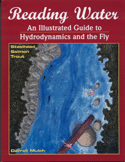
Reading Water
Darrell Mulch
Frank Amato Publications
Portland, OR 2001
62 pages, softbound
illustrated, color
suggested price, $15.00
reviewed by
Bruce E. Harang
This
book presents a novel and interesting system of fishing for steelhead,
salmon and trout. The basis for this system is how flies are acted upon by
various hydrodynamic forces and how various fly tying materials react to
these same forces.
The book opens by describing five characteristics of moving water,
namely, surface tension, inertia, direction, density, and turbulence. It
then describes six styles of flies that utilize the characteristics of
moving water to entice fish to take the fly. These six fly styles are dimple
flies, waking flies, appendage flies, fin flies, undulate flies, and hinged
flies. The author then provides detailed information on what styles of
flies, types of materials are most effective for each of the moving water
types and river hydrodynamics for the most common stream geographies.
The book is well written, though there are a number of typos not
caught by the editor. The illustrations are both interesting and effective.
They are computer generated 3D graphics which provide both the normal
perspective and the ability to see hidden features, such as water currents,
simultaneously. The quality of the illustrations, printing, and binding are
excellent.
If you are interested in a novel way of looking at the age old
problems of what fly to use, and how to use it at any given time, this book
will be a welcome addition to your library. Whether you subscribe to the
whole system or not, you will find many ideas and suggestions to allow you
to tie better flies and fish your rivers more effectively.
© 2001 Bruce E. Harang
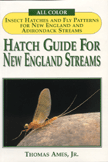
Hatch Guide for New England
Streams
by Thomas Ames, Jr.
Frank Amato Publications, Inc.
2000
271 pages, softbound
illustrated, Color
suggested price $19.95
reviewed by Bruce E. Harang
Don’t let the title,
or small format size, of this fine book fool you. As you are well aware, the
aquatic insects of the Southern Appalachian Mountains are the same ones
found farther north in New England and the northern end of the Appalachian
mountain chain. The format size of about 4” by 6” only means you can carry
this valuable resource in your jacket or vest pocket for use in the field.
The first thing that grabs your attention when you peruse this
book is the outstanding quality of the photography. These photos of insects
and flies are as good as any in publication. They are superior to many of
the published photos available in books costing many times more than this
one. Simply put, these are the finest photographs of insects I have had the
pleasure to view.
Once you start reading this book in earnest, you find that the
editing and layout are also of the highest caliber. The only other fly
fishing publisher with the same high standard of editing is the Lyons Press.
The layout is especially well suited to using this book for tying flies to
match the hatch. Each left-hand page has a great quality photo of the actual
insect on the top third of the page. The bottom two thirds of each page
contains information on the name of the insect or class of insects, physical
description, as well as habitat and geographic preferences, habits and
movement patterns. On the facing right-hand page is a photo depicting
suitable imitations covering the top one third of the page. The bottom two
thirds of the page contain information on tying techniques, fishing methods,
and locations on the stream to use the fly patterns.
All of the major aquatic insects important to trout are covered
including Mayflies, Caddis flies, Stoneflies, True flies, Damsel & Dragon
flies, true midges, terrestrials, and other food sources of value to the fly
fisherman in the pursuit of trout with a fly.
If that is not enough there are also sections with excellent,
practical information on presentation of wet flies, nymphs, and dry flies,
as well as information on tackle and general fishing information and
stories.
The book is completed by the reproductions of wonderful
watercolors by David B. Tibbetts.
At $50.00, this small format book would be a valuable resource.
At $19.95, it is a valuable resource vastly undervalued. If you fly fish for
trout east of the Mississippi, you must have this wonderful volume. It will
soon become a good friend.
© 2001 Bruce E. Harang
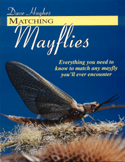
Matching
Mayflies
Dave Hughes
Frank Amato Publications
Portland, OR 2001
83 pages, softbound & spiral hardbound
illustrated, color
suggested price, $25.00 and $39.95
reviewed by Bruce E. Harang
Dave
Hughes has written a number of extraordinary books on fly fishing and
especially fly-tying. What makes his books so popular, and sets them apart
from most others, is the clarity of observation, succinct writing style, and
practical solutions. This short volume of 83 pages is another prime example
of his amazing talent to succinctly observe a multitude of information and
distill it down to a system of tying and fishing which produces optimum
fishing with a minimalist game plan.
Directed to matching Mayfly populations throughout North America
and the world, this book accomplishes its goal well. The book starts with a
chapter explaining the simplicity of Mayfly trigger points for trout. The
trigger points of size, shape, and color. And that all Mayflies have the
same wing shape, body shape, and tail design. Thus, matching Mayflies does
not require a degree in aquatic entomology. It only requires a desire to
observe your surroundings when on the stream and then match the few trigger
points to catch trout. There is also a concise description of the life cycle
of Mayflies in a short but well written chapter.
The meat of the book resides in the four chapters dealing with
matching Mayfly nymphs, emergers, duns, and spinners. Each of these chapters
describes the various forms of Mayfly and suggests patterns for imitative or
impressionistic patterns. Finally, each chapter ends with a discussion of
how to fish these Mayfly patterns for best effect. The text is beautifully
complimented by the outstanding color photographic reproductions and color
illustrations. The step-by-step tying instructions are extremely well done
both as to text and illustration.
The gravy is the one page universal fly box that concludes the
book. Here is a suggested set of Mayfly patterns that will help the fly
fisherman catch trout on most types of water in most parts of the world.
This page alone is worth the price of the book.
If you are looking for a book to help you tie and fish a limited
number of patterns for Mayflies without sacrificing your ability to catch
trout, this is the book to purchase.
© 2001 Bruce E. Harang
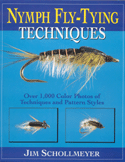
Nymph
Fly-Tying Techniques
by Jim Schollmeyer
Frank Amato Publications
Portland, OR 2001
125 pages, softbound & hardbound
illustrated, color
suggested price, $23.95 & $40.00
reviewed by
Bruce E. Harang
This
volume is a reference work for fly tiers directed to a single topic, tying
nymphs. As such it is a specialized reference work which collects most of
the tying techniques and procedures for tying nymphs in a single volume. The
book is organized into a first chapter covering the understanding and
handling of hooks, thread, and materials allowing the fly tier to construct
well tied, properly proportioned nymphs. Included are discussions on
mounting materials, trimming materials, preparing materials, underbodies,
tails, bodies, ribbing, legs, wings, hackle, eyes, and bead heads. Chapters
2 through 6 teach the various types of bodies used on nymphs. These include
lashed and extended bodies; strand bodies; herl, barb, feather and quill
bodies; dubbed bodies; and bead, pulled, stacked, spun and woven bodies. For
instruction on tying nymphs from midge larvae to giant stonefly nymphs there
is no better reference work.
While this is not a pattern book, it does utilize many popular
nymph patterns in teaching the various methods and nymph styles. This is
accomplished using excellent, well edited text, and over one thousand
photographs of the tying sequences covering all of the topics in the book.
The quality of the printing, the photographs, and photograph
reproductions is outstanding. The softbound edition is well bound so that it
will last through many years of hard use at the tying bench. The hardbound
edition is done with a spiral binding within the hardbound covers allowing
the book to be laid open flat on the tying bench. Both editions are a real
value for all fly tiers interested in learning, or in improving the quality
and diversity of, tying nymphs.
© 2001 Bruce E. Harang

The Caddisfly Handbook
by Dick Pobst & Carl Richards
The Lyons Press
New York, NY, 1998
113 pages, hardbound
illustrated, Color and B&W
suggested price: $19.95
reviewed by
Bruce E. Harang
The authors have done a great service for the fly fisherman with the
publication of this book. This is clearly the best “field guide” style work
directed to the Caddisfly available. The photography is of the extremely
high standard associated with all the previous works of Carl Richards and
Doug Swisher. You will not be disappointed with either the photographs or
the insects or those of the patterns to imitate the real insects with. The
format of the book where the photograph of the actual insect and its written
information on one page and the photograph of its imitation and pattern
recipe on the facing page provide all necessary information for each insect
in a single view format most helpful at the tying bench. No need to flip
pages here while tying your Caddisfly imitations.
The anatomical drawings
in the “key” section of the book are of the highest caliber as to
illustrating the various body parts. Unfortunately they seem to be computer
created images which have been enlarged past the limitations of their
original low resolution and therefore look ragged and lack sharp precise
lines. Interestingly, the line drawings in the main body of the book are
both clear and precise.
You will not find a better Caddisfly field guide directed to the fly
fisherman anywhere. If you fish Caddisfly imitations you must have this
book.
©
1998 Bruce E. Harang
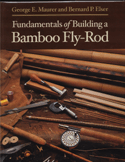
Fundamentals of Building
a Bamboo Fly-Rod
by George E. Maurer & Bernard P. Elser
The Countryman Press
Woodstock VT, 1998
255 pages, hardbound
illustrated, B/W photos
Suggested Retail, $50.00
reviewed by
Bruce Harang
Surprisingly, in an
otherwise literature rich sport, there have been few quality
fly-rod-building books. The ones that come readily to mind are AMATEUR
RODMAKING, by Perry D. Frazer in 1914, A MASTER'S GUIDE TO BUILDING A BAMBOO
FLY ROD, by Everett Garrison in 1977. Thus, when a book on fly rod building
is published, it is greedily snapped up. Usually, however, the new books
turn out to be both poor in quality and short on useful information.
With the publication of the authors' book a new star has risen
in the craft of fly-rod building. The book is clearly written with excellent
editing and superb layout and design. The reader will gain the necessary
information to successfully build bamboo fly rods. Moreover, he will
thoroughly enjoy doing so because of the fine writing. The photographs
clearly illustrate the text they accompany. If there is a downside to this
book it is the average quality of the photograph reproduction. While the
photographs are clear enough for the reader to understand what is
illustrated, they are not up to the same standard as the rest of the book.
What the authors have done is combine the years of experience of
a professional bamboo fly rod builder with the questioning insight of a
beginner to provide a book that clearly teaches the reader how to
successfully build a bamboo fly rod. Everything in the way of tools,
materials, and procedures is here. Moreover, it is provided with enough
detail to allow success without unnecessary minutia to cause confusion. For
example, instead of dozens of rod tapers, the authors provide the reader
with 18 rod tapers, which provide great fly rods while being straight
forward enough to allow the beginner to find success from the start. At the
same time the authors provide a clear and concise explanation of taper
design to allow the reader to develop more involved and personalized rod
tapers as he gains in experience.
The book contains a good list of suppliers of all of the tools
and materials the bamboo rod builder requires. In addition, the book
contains clear and concise descriptions and instructions for building the
tools that are either unavailable commercially, or as an alternative to
expensive ready-made products. Also included is a glossary of technical
terms used in the bamboo rod building craft. The book simply will not let
the beginning rod-builder flounder in the dark.
Countryman Press must also take credit for a wonderfully
designed and implemented publication. The binding, paper stock, dust jacket
photograph, and overall printing are all of the highest quality. These
factors are not often appreciated, but go a long way toward making this book
easy to read.
Overall, one of the finest instructional books you will find,
and a must have volume for any serious fly fishing library.
© 1998 Bruce E. Harang
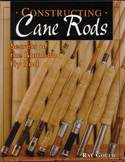
Constructing Cane Rods
by Ray Gould
Frank Amato Publications, Inc., 1998
Portland, OR
84 pages, Spiral Hardbound
illustrated, Color
suggested price, $39.95
reviewed by Bruce E. Harang
This slim volume
contains thirteen short chapters that provide an excellent overview of the
craft of bamboo fly rod making. The book is very well illustrated with color
photographs. However the quality of the color plates is very inconsistent.
Many color plates are top quality and many are mediocre to poor in quality.
The book provides four chapters on the building of bamboo fly
rods, two chapters on the history and physical properties of bamboo, two
chapters on rod care, one chapter on utilizing a personal computer in fly
rod taper design, two chapters on rod builders and rod building trends, and
a chapter on where to find materials and equipment needed to build bamboo
fly rods. This mix of topics provides a very good overview of bamboo fly rod
building for anyone interested in this reemerging craft.
Points of special interest include methods and tools to
retighten loose ferrules, comparison charts between silk line designations
and modern line weight numbers, and using a computer for developing rod
tapers.
The spiral bound hardcover large format is an excellent choice
for a book you will want to have next to you at the work bench. The choice
of a dull finished heavy paper stock further enhances the usability of the
book.
Overall, a good general overview of construction bamboo fly rods
seeded with numerous true gems of information. While this book will not get
a beginner building quality bamboo fly rods, it certainly is a good overview
of the whole process, and a worthy addition to your bamboo rod building
library.
©
1998 Bruce E. Harang
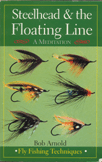
Steelhead & the
Floating Line A Meditation
by Bob Arnold
Frank Amato Publications, Inc.
Portland, OR, 1995
167 pages, softbound
illustrated, color and B&W
suggested price, $ 15.95
reviewed by Bruce E. Harang
Bob Arnold is
undoubtedly one of the most devoted wild Steelhead fly fishers alive today.
More importantly, Bob is also undoubtedly one of the Steelhead's greatest
proponents. Bob has spent the better portion of his life in a mad love
affair with a siren dressed in molten silver with crimson blazes, This
passionate love affair has taken Bob on many an outing to pursue a fish of
which legends are made. The wild Steelhead of mystic rivers such as the
Stillaguamish, and Wenatchee. It has taken him to the shores of Steelhead
Rivers and smoky barrooms with the giants of Steelhead fly fishing history.
Most importantly it has lead Bob to be a leader in the fight to save the
wild native Steelhead of the Pacific Northwest.
All of his love and passion for this great fish and its habitat
comes through in this book. You can not read this book without feeling the
quickening of Bob's pulse and the rise of his blood pressure every time he
speaks of his favorite rivers and the fish they produce. His enthusiasm is
infectious. But there is more, far more. Bob tells the history of Steelhead
fly fishing through the stories and experiences he has shared with the
giants of this unique fly fishing quarry. Men such as Syd Glasso, Wes Drain,
Lee Wulff, and George McLeod.
Sprinkled like gold dust throughout this remembrance is the
knowledge and skills learned over decades of fly fishing for Steelhead. For
the reader who is willing to learn, Bob provides a doctorate program in
successfully fly fishing for Steelhead. Careful attention paid to the fly
fishing information in this book will make any fly fisherman a better
Steelhead fly fisher. It will more over make any fly fisherman a better fly
fisherman no matter what his quarry.
Overall, a wonderful book which should be read by every fly
fisherman interested in our sport. The information is worth far more than
the price of the book. The wonderful stories and history of Steelhead fly
fishing in the Pacific Northwest is also worth the price by itself. Get this
book, read it, and be inspired.
©
1998 Bruce E. Harang
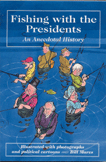
Fishing with the Presidents
by Bill Mares
Stackpole Books
Mechanicsburg, PA 1999
illustrated: Black & White
255 pages, softbound
suggested price: $14.95
reviewed by Bruce E. Harang
The author has provided
all of us with an insightful history of fishing and its relationship to our
Presidents and presidential politics. Included in this work are
reproductions of political cartoons and illustrations that document our
changing attitudes, awareness and appreciation of fishing and our national
leaders.
Here you can learn about the leisure time practices of great
outdoorsmen such as “Teddy” Roosevelt, great generals such as Dwight
Eisenhower, and generally good people the likes of Jimmy and Roslyn Carter.
In addition, you will laugh at some of the amusing fishing events that
occurred to provide fodder for the political grist mills.
A book full of history of our leaders and amusing side-lights of
great and near-great leaders. Well worth the price of admission.
© 1999 Bruce E. Harang

Trout Flies and Flowers
by Ivan L. Mahoney
Lukken Color Corp.
Greenwich, CT 1998
49 pages, plus 30 note pages, hardbound
illustrated, Color and B&W
suggested price: $19.95
reviewed by Bruce E. Harang
This little book brings
a new and fascinating facet to fly-fishing. Using the blooming of plants to
determine what flies are hatching. We have all become familiar with hatch
charts. Therein are listed flies with calendar dates telling when the
particular fly will hatch. Then, like in an English textbook, there are
listed the exceptions to every rule. There are variations for geographical
areas and wide ranges of dates for example. Thus, the angler is left to
ferret out the actual hatching periods for himself.
This book is based on the established biological principal that
both the blooming of plants and the emergence of aquatic insects is
determined largely by temperature and light levels. When the fly fisherman
sees the maple trees just beginning to show red he will also see the Quill
Gordon Mayfly, for example. It does not matter if you are in the Northeast,
Midwest, or South. If there are maple trees and there are Quill Gordon
Mayflies they will bloom together. Besides listing several indicator plants
for each of fifteen different important hatches the author also gives dry,
wet, and nymph patterns for each fly as well as water types where the angler
should look to find the particular fly.
The color plates and botanical illustrations by Veva Crozer are
both magnificent. The color printing is superb.
Overall, here is a wonderful volume to read and to use on the
stream.
© 1998 Bruce E. Harang
|










